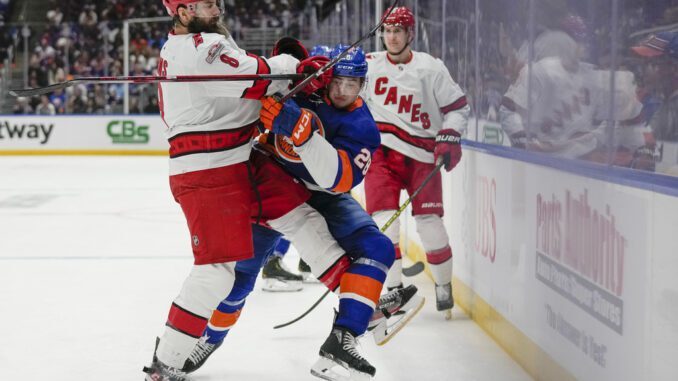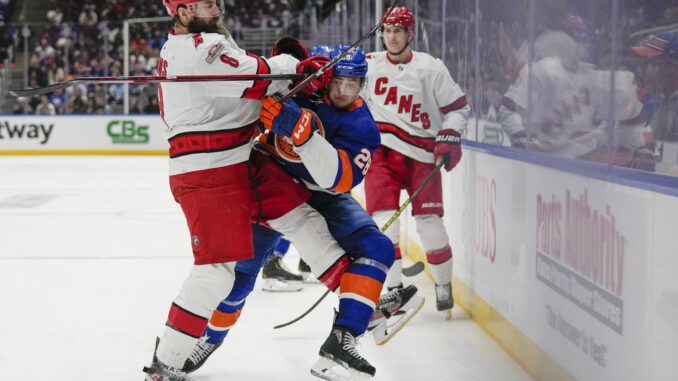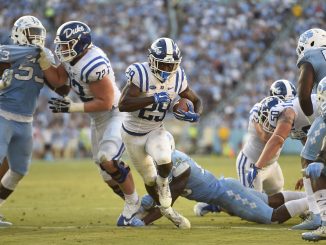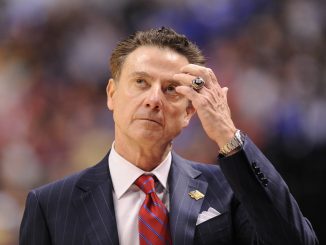

NEW YORK — The Hurricanes opted not to skate Saturday, choosing rest over ice time ahead of Game 4 at UBS Arena. With Sunday’s game at 1 p.m., there will also be no morning skate before the game. Carolina leads the series 2-1.
1. The Hurricanes’ main concern coming out of Game 3 was the team’s power play.
Carolina went 0-for-4 and managed just three shots on goal.
“Yeah, it wasn’t good,” Hurricanes coach Rod Brind’Amour said from the team’s hotel on Saturday. “We rushed things. We got in and we got set, and then it was just guys trying, I think, to see if we can score and not let the plays that we try to run happen.
“And then we’re just a little out of sync and didn’t really even have a good look. … A couple of little shots here or there, but nothing that was threatening. Maybe one that actually didn’t get through. We didn’t let it happen, and we’ve got to trust ourselves a little more.”
Carolina is 3-for 14 (21.4%) in the series, but one of those goals (the own goal by the Islanders’ Sebastian Aho) was a fluke and the final “failed” chance on Friday never happened — it came with two seconds left in the game and the officials didn’t even drop a puck for it.
“I think the intentions are all good,” Brind’Amour said. “Everybody’s trying to do the right things. It’s just I think we try a little too hard sometimes in that area because we know how important it is. We know that’s our chance to win the game.”
Brind’Amour said the power play units could be shuffled around for Game 4, “but that’s not really the issue.”
2. You can throw out the final few minutes of Game 3: Antti Raanta has been up to the task of going head-to-head with Islanders goalie Ilya Sorokin.
Raanta’s numbers this postseason (.909 save percentage; 2.60 goals-against) are a bit skewed by the two meaningless late-game goals he allowed after Kyle Palmieri’s power play goal that proved to be the game-winner.
“He certainly has done his part,” Brind’Amour said. “You don’t worry about the last couple of minutes. At that point, nobody’s worried about that. So he kept us in the game and that’s what we want.”
Sorokin has a .933 save percentage and 2.29 goals-against average through three games. According to MoneyPuck.com, Raanta has a Goals Save Above Expected Per 60 (GSAx/60) of 0.423, slightly higher than Sorokin’s 0.392.
What had been perceived by some as a question mark entering the series has instead been a strength for Carolina.
“He’s been great,” center Jesperi Kotkaniemi said. “We had a couple tough stretches in the game, (and) he kept us in the game the whole time. It’s huge to have a great goalie in playoffs.”
3. One statistic that jumped out to me following Game 3? Brent Burns finished with just one shot on goal, including none at 5-on-5. That’s after having six overall shots (five at 5v5) in Game 1 and four (one at 5v5) in Game 2.
In fact, just eight, or 25.8%, of the Hurricanes’ 31 shots on Friday came from its defense. During the regular season, 32.7% of the Hurricanes’ shots (933 of 2,852) came from the blue line.
Burns finished without a 5-on-5 shot on goal 10 times during the season, and, curiously, Carolina was 8-0-2 in those games. That record is surely an anomaly — the Hurricanes are better when Burns and his fellow blueliners are firing the pucks from all over the ice, and they will need to do more of it in Sunday’s Game 4.
4. As a whole, Carolina has struggled to score at 5-on-5 in the series. They were blanked at even-strength in Games 1 and 3, but the Hurricanes did score three times in Game 2.
“I don’t think we’re struggling,” Hurricanes captain Jordan Staal said. “I think we’re getting a lot of chances and not giving them much. So it was a tight game last game. You know, 1-1, five minutes left. I don’t think it was a struggle, and we had plenty of chances to get a few in as well.
“So if we continue to play our style and get as much volume as we can and keep creating chances and playing in their end, I like our chances.”
For the series at 5-on-5, Carolina has a 52.81% Corsi For but just 42.19% of the high-danger scoring chances, according to NaturalStatTrick.com. For the entirety of the regular season, those numbers were 60.38% and 58.71%, respectively.
The Hurricanes had maybe their best period of the series in the first 20 minutes of Game 3 with a 64.71% Corsi For and a 4-2 edge in high-danger chances. But the Isles rebounded in the second and third when penalties limited 5-on-5 time to under 26 minutes (compared to 17:26 in the first).
The Hurricanes would probably benefit if fewer penalties are called in Game 4.
5. There’s been plenty of physicality in the series, and that’s something that suits the Islanders and feeds into their identity. The Hurricanes seem to be enjoying it.
“This is real hockey, for sure,” Kotkaniemi said. “Everyone is flying out their elbows high, sticks high. That’s what everyone loves. … I think it’s awesome, like gladiators out there. It’s fun.”
Still, the Hurricanes have been on the receiving end of the bigger hits in the series, including Islanders defenseman Ryan Pulock leveling Carolina rookie Jack Drury on the opening shift of the series, Jean-Gabriel Pageau sending Martin Necas into the New York bench in Game 3 and Casey Cizikas hitting Kotkaniemi late in the waning seconds of Friday’s game.
The last hit led to a combined four misconducts plus the aforementioned roughing minor for Cizikas.
“Yeah, that was a little late,” Staal said. “But, you know, it’s obviously playoff hockey.”



